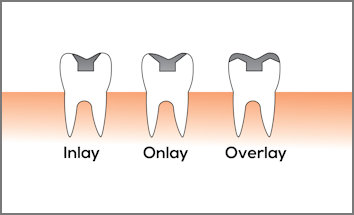Dental Inlays and Onlays
 Dental inlays and onlays are dental restorations used to repair teeth when you need more than a filling but less than a full crown.
Dental inlays and onlays are dental restorations used to repair teeth when you need more than a filling but less than a full crown.
They are used to restore broken or decayed teeth, to replace large or fractured fillings, and to enhance your smile by replacing silver fillings.
The distinction between inlays and onlays is that onlays are used to cover one cusp or more, whereas dental inlays tend to be used more as a filling between the cusps.
- Inlays are used as an alternative to fillings for their additional strength.
- Onlays (shown above) are used to conserve natural tooth structure when you don’t need a full crown.
Luckily, you don’t need to be an expert on tooth restorations. Dr. Nielsen will be able to tell you the best restoration options for your specific situation.
Most inlay or onlay restorations are made of composite material, tooth colored porcelain, or gold by a professional dental laboratory. When they are returned from the lab Dr. Nielsen will bond them in place to fully restore the beauty and function of your tooth.
Dental inlays and onlays are highly durable and will last many years, giving you a beautiful, long lasting smile.
More About Dental Inlays and Onlays
Inlays and onlays, essentially, restore structural integrity to a tooth to serve both as a functional and an aesthetic benefit. Dental inlays and onlays can also be referred to as “indirect fillings” or “partial crowns”.
They differ from fillings in that fillings can be done if only a small portion of the tooth has been compromised by a cavity. If decay is substantial enough to undermine tooth integrity, an inlay or onlay is chosen.
They are more intensive than a filling but are less intensive than a crown. Crowns require the removal of the healthy portion of a tooth which is the reason onlays are preferred.
Inlays and onlays may consist of composite resin, porcelain or gold. Gold can last a longer time; however, porcelain and composite resin match the color of the surrounding tooth and is more aesthetically-pleasing.
With good oral hygiene, porcelain and composite resin last a long time and help to protect the tooth from further damage.
Inlays
Inlays are chosen when a portion of the tooth needing to be restored is more extensive than what can be remedied by a filling. Inlays affect the creviced area of the tooth and does not include the outer cusp.
Onlays
Onlays are like inlays, but they incorporate the outer cusp of the tooth because of damage to the cusp. Usually, onlays are done when the tooth becomes fractured on the cusp of the tooth or is otherwise compromised. Onlays are also chosen if the entire tooth does not need a crown.
The Benefits
An inlay or onlay does not require removal of the healthy portion of the tooth to be adhered. Both inlays and onlays are less likely to change in color over time, which adds to their aesthetically-pleasing properties.
Teeth are easy to clean with inlays and onlays because the edges of both are made minimally to avoid further tooth decay. Inlays and onlays add strength to damaged teeth.
The Procedure
Inlays and onlays can be accomplished in two appointments. The damaged area of the tooth is removed and an impression is made of the tooth and the surrounding teeth. This is to ensure a proper fit so that your teeth can still achieve a proper bite.
A temporary restoration is used on the tooth to protect it and provide comfort. During the following appointment, either the inlay or onlay is bonded to the tooth.
Inlays and onlays are excellent options because they both preserve the integrity of the tooth while enhancing both its functional and aesthetic qualities.
Through the use of x-rays and expertise, dentists are able to inform their patients whether they are good candidates for either of these procedures which many times are the best solution